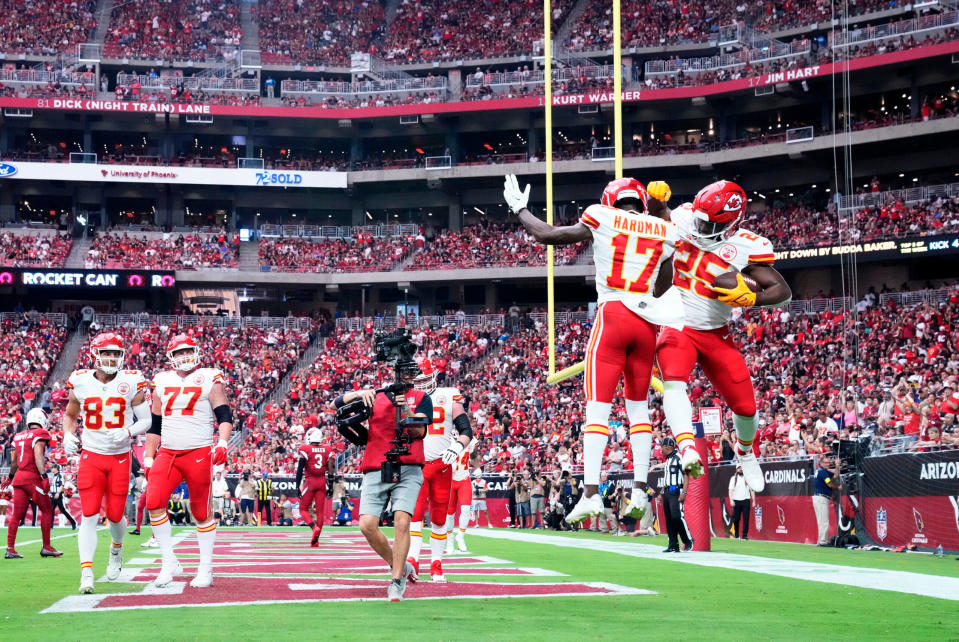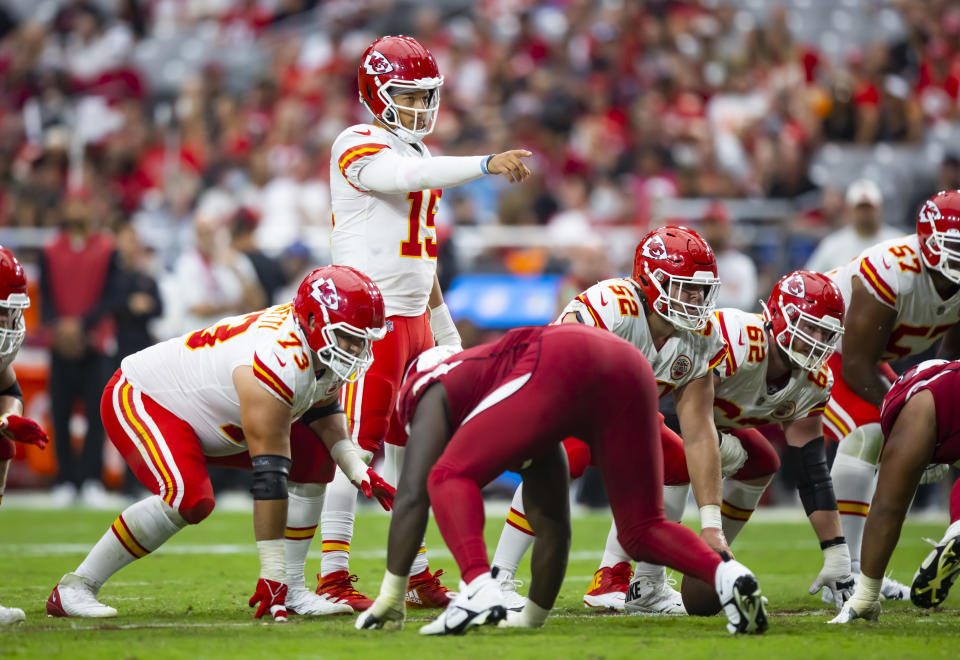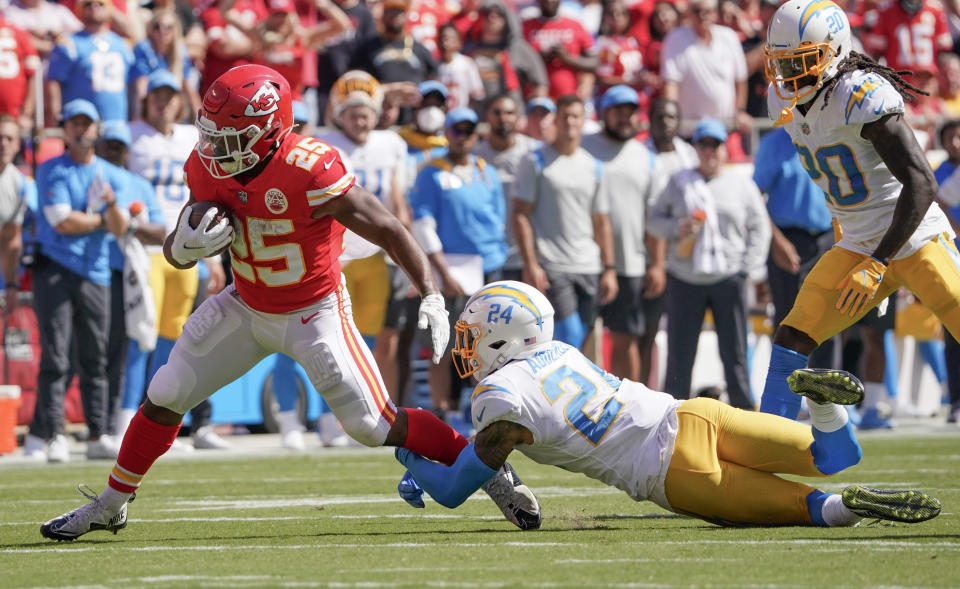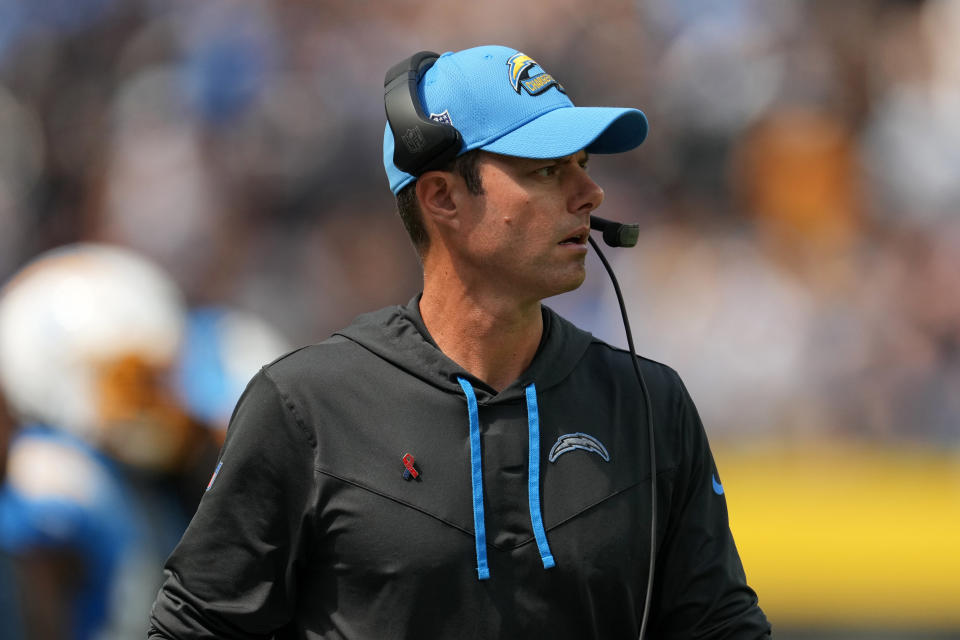Why the Chiefs’ new offensive wrinkles could spell trouble for the Chargers

When the Kansas City Chiefs and the Los Angeles Chargers face off on Thursday night to start Week 2 of the 2022 regular season, everybody will be talking about Patrick Mahomes and Justin Herbert. And with good reason — Mahomes just demolished the Cardinals in Week 1, and the Raiders didn’t have too many answers for Herbert, either. But there are other matchups within the matchups, and things you see on tape as you go along.
Regarding this game, what you want to watch for is the Chiefs’ run game versus the Chargers’ run defense. Two things that did not work well at all last season, and both teams are looking to turn those trends around as quickly as possible.
In their Week 1 rematch against a Raiders team that absolutely blew their run defense out of the ballpark and took them out of the playoffs as a result, the Chargers allowed just 64 yards on 13 carries from Josh Jacobs and Brandon Bolden. Limiting Jacobs (especially) took a specific schematic constraint that worked, and we’ll get into that in a minute, but as well as that went, the Chargers had best be ready for a Chiefs run game that all of a sudden does not at all resemble the gimmick-heavy stuff they were trying to make work last season.
Brandon Staley, the Chargers’ head coach, defensive mastermind, and noted light-box advocate, was asked on Tuesday why the Chiefs are such a great red zone team. His answer really applied to all levels of the field.
“Because you have to defend all five people and the quarterback. Any time all five people are a legitimate threat to do something with the football down there, and you have to account for the quarterback, you’re maximizing your chances of being an outstanding red zone team. They run the football well down there because they can run it, and they can get the RPO version of the game, so they can change the math, even the math out down there. They’re an outstanding screen team. A very, very tough cover. That’s why they’re such a good football team.”
That’s Staley’s challenge. The challenge facing Kansas City head coach Andy Reid and offensive coordinator Eric Bieniemy is how to best deal with a Chargers team that will understand everything they’re bringing to Arrowhead Stadium on Thursday night.
Here’s how that might look once it’s game time — and why Staley may be outnumbered no matter what he calls.
Andy Reid's screen game is back with a vengeance.

(Syndication: Arizona Republic)
Andy Reid has long been known as one of the best designers of screen passes in the NFL, and against the Cardinals, it worked very well. Mahomes completed all four of his screen attempts for 32 yards and one of his five touchdowns. But with screens, you don’t want the numbers; you want to see how it all works.
This 25-yard screen to Clyde Edwards-Helaire with 7:01 left in the first quarter had Edwards-Helaire flaring and chipping to the right, then releasing for the throw. Tight end Travis Kelce and receiver Mecole Hardman took the top off to the right side, with Hardman running a vertical route. Kelce ran an intermediate route out of motion from left to right, but his primary responsibility here was to block Cardinals safety Budda Baker, the hook/curl defender to that side.
Which Kelce did with authority. 25 yards later, Reid’s screen game was back in the saddle. And this was out of 13 personnel — one back, one receiver, and three tight ends! More on that in just a second.
Against the Chargers’ defense in Week 1, Raiders quarterback Derek Carr preferred to his his backs in the passing game with swing passes and release routes; there weren’t a lot of coordinated screens. So, we’ll see how Staley adjusts to Reid’s screen game. Most likely, he’ll see a lot of it.
Kansas City's personnel packages are more diverse and effective.

(Mark J. Rebilas-USA TODAY Sports)
Last season, the Chiefs’ personnel distribution looked like this:
11 personnel (one running back, one tight end, three receivers): 67%
12 personnel (one running back, two tight ends, two receivers); 20%
13 personnel (one running back, three tight ends, one receiver): 5%
What was the difference in Week 1 of this season? All of a sudden, Reid and Bieniemy had a two-back package, and it was definitely on point. The personnel distribution from the Cardinals game:
11 personnel (one running back, one tight end, three receivers): 58%
12 personnel (one running back, two tight ends, two receivers); 17%
13 personnel (one running back, three tight ends, one receiver): 11%
22 personnel (two running backs, two tight ends, one receiver): 9%
Rookie running back Isiah Pacheco, who made our Secret Superstars team this week, benefited most. The Rutgers alum gained 61 yards and scored a touchdown on 12 carries, and 33 of those yards on eight carries came in 22 personnel sets. 46 of Pacheco’s total yards came after contact, and he had three runs of 10-plus yards. The combination of Pacheco and Edwards-Helaire seems to give this offense a new look in the power game, and fullback Michael Burton was also a factor.
It was a marked improvement over, and difference from, Kansas City’s run game in 2021, which consisted primarily of gimmick sweeps and the occasional successful zone run play. Now, the Chiefs are engaging in intelligent smashmouth, and it’s beautiful to see.
On this 25-yard Pacheco run with 4:24 left in the game, Burton (No. 45) immediately set to block outside linebacker Victor Dimukeje (No. 52), while tight end Noah Gray (No. 83) went all the way across the formation from a left H-back position to block end linebacker Tanner Vallejo (No. 51). Pacheco’s run up the middle was greatly assisted by center Creed Humphrey (No. 52), who blocked tackle Rashard Lawrence (No. 90) right out of the way. Meanwhile, right guard Nick Allegretti (No. 73) and right tackle Prince Tega Wanogho (No. 70) doubled end Michael Dogbe (No. 91) and Allegretti had the time to head up to the second level to stop linebacker Zaven Collins (No. 25) from blowing anything up.
Whew. The next time somebody tells you that run plays are simple, show them this.
Folks, the Chiefs are now engaging in intelligent smashmouth.
Adjust your expectations accordingly. pic.twitter.com/9QEsqc4v2j
— Doug Farrar ✍ (@NFL_DougFarrar) September 14, 2022
Of course, the Chiefs can also throw the ball deep out of heavy personnel, which can just mess up your pass defense. I loved this switch release crosser from Mahomes to Kelce with 12:07 left in the third quarter. Kelce runs the switch with fellow tight end Jody Fortson (No. 88), and the Cardinals pick it up pretty well, but Mahomes makes one of his impossible throws, and that’s that.
However the Chiefs move the ball, Reid doesn’t seem to care at this point — he just wants the ball moved. But Reid seemed to take extra pride in the run game when he spoke with the media on Tuesday.
“Running is part of it and then throwing is part of it I think a mix becomes big, but when you need to run the ball or want to run the ball you should be able to do that. That’s the challenge. So, when we call, when we dial them up, let’s go. There’s a certain attitude that goes with that. That’s where the emphasis has been. Our guys – the linemen like doing it. If you told a lineman he could pass-block or run-block, he’s going to tell you run block you know that right? He’s going to go run block. They enjoy that.”
At this rate, they’re going to enjoy just about everything.
The Chargers might not be ready for this.

(Denny Medley-USA TODAY Sports)
In Week 1, the Raiders didn’t hit Staley’s defense with a lot of this stuff — they ran 11 personnel on 82% of their snaps, 22 personnel on 13% of their snaps, and that was about it. So, with the Chargers’ alleged improvements to stop that run defense to avoid getting gashed by heavier personnel packages, we have to go back to last season.
Which I’m sure Staley would prefer that we didn’t do. Because last season, the Chargers gave up more rushing yards (176) and more rushing touchdowns (three) against 22 personnel than any other team, and only the Broncos (46) faced more runs out of 22 than the Chargers’ 42.
Against 12 personnel, the Chargers allowed 556 yards and two touchdowns on 113 carries, and against 21 personnel, they allowed 211 yards and three touchdowns on 53 carries. They played light boxes against heavy personnel on 28% of their defensive snaps, and they were the NFL’s worst team in Positive Play Rate when they did. Not that they were much better when they stacked the box against heavy packages — they did so 33% of the time, and ranked 26th in PPR.
The Chargers worked to improve their notoriously bad run defense with the additions of veterans Khalil Mack and Sebastian Joseph-Day, along with UCLA fifth-round rookie Otito Ogbonnia. So, that’s the new-look matchup to zero in on for this game.
How can Brandon Staley change the math?

(Kirby Lee-USA TODAY Sports)
What may be interesting from Staley’s point of view is how well the Chargers’ five-man fronts worked against the Raiders when Jacobs did run out of heavy packages. Josh Jacobs ran four times out of heavy personnel, the Chargers countered with five-man fronts on three of those plays, and Jacobs gained just 13 total yards. Using different kinds of Bear packages countered the power run game in ways the Chargers didn’t see in 2021.
This play is just hat-on-hat violence. Rookie nose tackle Otito Ogbonnia (No. 93) takes the center and right guard, leaving one-on-ones across, linebacker Kyle Van Noy (No. 8) takes out the fullback. Ogbonnia sort of stopped Jacobs without knowing it, which is pretty cool.
The Chargers will have to be as coordinated in their run-stopping efforts as the Chiefs are in their run concepts. Of course, if you’re going five across with the line, someone might be open in that Kansas City passing game. The Cardinals stacked the box on eight of Mahomes’ passing attempts; he competed five of those attempts for 38 yards… and three touchdowns.
So, pick your poison, Coach Staley.

